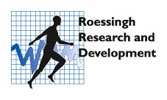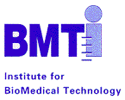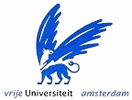Development of a portable movement laboratory.
‘Movement in HealthCare'
Background
Complaints of the human movement apparatus are a large social-economic problem. Because of increasing lifespan and specialization at the work place an explosive growth is induced. Important patient groups (elderly, sports injured, and people with work related complaints) are depending on correct qualitative and quantitative assessment and analysis for optimal diagnosis and treatment. Currently more peripheral echelons of health care can not offer this optimal assessment to their patients. To facilitate this it is required that every health care professional can access adequate instruments and methods for qualitative and quantitative assessment of their patients complaints and disorders.
The necessity for increasing objectivities of patient assessment in more peripheral echelons of health care is also increased by other current trends in health care. E.g. decisions around patients are more and more discussed in multidisciplinary teams with members at different locations and with different background rather then by individual clinicians. To avoid increasing miscommunications more objective assessment and description of complaints and disorders are required. The presence of these more objective methods would significantly enhance quality of life for large groups of people. Also the resulting more optimal assessment and treatment would lower costs in health care in general.
Problem definition and objectives
There is a clear need for knowledge, methods and tools to become available for objective diagnostics (and prevention) of disorders to the movement apparatus. This knowledge is up to now only present in some large specialised movement laboratories in our country. The FreeMotion research project examines the possibilities of a complete 3D motion analysis method with the restriction of only body worn sensors, a ‘portable movement laboratory’. From the FreeMotion project derived tools should be applicable for the named patient groups in their normal environment and available to general practitioners, physical therapists, rehabilitation doctors, human engineers and ergonomists.
Approach
The FreeMotion consortium examines methods and techniques for measuring 3D posture, movement and loads applicable on every relevant location (figures 1 and 2). The project examines, besides the technological aspects of the portable instruments, all relevant biomechanical and methodological aspects for effective clinical application. The project produces knowledge concerning methods, algorithms, protocols, representation and interpretation of clinical, ergonomic and sport-related applications.
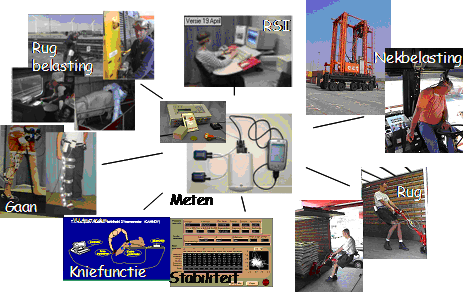
Figure 1: Examples from earlier practical studies of ambulatory measurements of the posture- and movement apparatus.
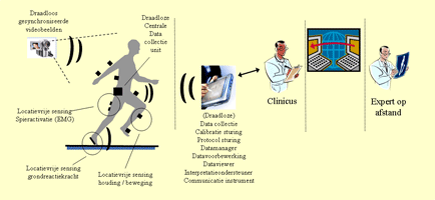
Figure 2: the FreeMotion concept. Miniature sensors on the body measure attitude, movement, muscle activity and groundreaction forces. This data is passed on wirelessly to a pocket pc or laptop where it is analysed further. When needed, the data may be discussed with a distant expert.
Contribution of the Biomechanical Engineering Group
The research of the Biomechanical Engineering Group is directed at the lower extremities, and in this project focussed on foot deformation modelling. This model will improve the accuracy of biomechanical estimates of the joint loads in an ambulatory set-up. A redesign of the sensor shoe (figure 3) will result in a wider applicability and improved accuracy of out-laboratory ground reaction force assessment. Furthermore, the group will contribute to the visualization and interpretation software of biomechanical data.
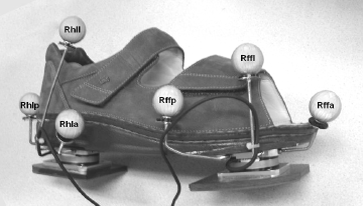
Figure 3: Sensor shoe with two miniature 6-D force plates mounted to measure ground reaction forces. For evaluation purposes some markers for motion capture are mounted as well.
Staff members involved in FreeMotion:
Prof. dr. ir. Bart Koopman (coordinator)
Prof. dr. ir. Herman van der Kooij
Drs. Edwin van Asseldonk (post-doc)
Ir. Martijn Klein Horsman (PhD student)
Consortium partners
The project is conducted by a group of 10 Dutch research groups and companies formally cooperating within the FreeMotion consortium. The FreeMotion project is funded by the Dutch Ministry of Economic Affairs.
| Roessingh Research and Development (RRD), EnschedeRRD is a (internationally) leading research institute in the field of rehabilitation technology- en pain-research. RRD is affiliated to rehabilitation center 't Roessingh in Enschede. RRD is initiator of the FreeMotion project and coordinates the FreeMotion consortium. |
| BMTI, University of Twente, EnschedeBMTI is an institute for all (bio-)medical research activities of Twente University. In FreeMotion both the Biomedical Signals and Systems Group and the Biomechanical Engineering Group participate. |
| Faculteit Bewegingswetenschappen, Vrije Universiteit, AmsterdamThe faculty of Movement Sciences in Amsterdam is a renowned scientific institute in the field of Biomechanics of the spine. The major part of its research is performed at the Instituut voor Fundamentele en Klinische Bewegings-wetenschappen (IFKB) |
| Biorobotics Laboratory, Technische Universiteit Delft, DelftThe BioRobotics Laboratory of the Delft Technical University is a research institute that targets issues of 'natural dynamics and biologically inspired robotics'. It is one of the leading groups in the field of biomechanics of the shoulder. |
| Department of Rehabilitation of the Free University Medical Center, AmsterdamAt the Motion Analysis Lab of the department of Rehabilitation of the VU Medical Center state of the art research is conducted in the field of gait analysis. Much attention is paid to making research results applicable in clinical practice. |
| Xsens Motion Technologies, EnschedeXsens Technologies is a highly specialized producer of 3D motion tracking products concentrated around miniature motion sensors. |
| re-lion, Enschedere-lion is a company that concentrates on research and development of products around visualisation and simulation in virtual environments with a natural man machine interface. |
| Noldus Information Technologies, WageningenNoldus is a multinational company that develops professional software and instrumentation for research of human and animal behaviour. |
| TNO Industry, EindhovenTNO Industry is a research institute with knowledge and experience on a vast number of technological areas. |
Related links
http://www.ambulab.nl/freemotion/

